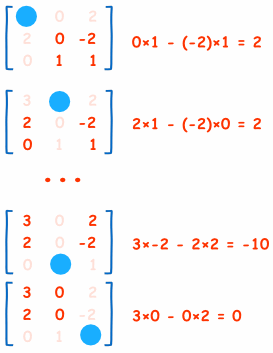how to find the cofactor of a matrix
Inverse of a Matrix
using Minors, Cofactors and Adjugate
Note: besides check out Matrix Inverse by Row Operations and the Matrix Calculator
Nosotros tin can calculate the Changed of a Matrix by:
- Stride 1: computing the Matrix of Minors,
- Pace two: and so turn that into the Matrix of Cofactors,
- Step 3: and then the Adjugate, and
- Step 4: multiply that by 1/Determinant.
But information technology is all-time explained past working through an case!
Example: observe the Inverse of A:
It needs 4 steps. It is all elementary arithmetic merely there is a lot of it, then try not to brand a mistake!
Step 1: Matrix of Minors
The first step is to create a "Matrix of Minors". This footstep has the nearly calculations.
For each element of the matrix:
- ignore the values on the current row and column
- calculate the determinant of the remaining values
Put those determinants into a matrix (the "Matrix of Minors")
Determinant
For a 2×two matrix (ii rows and 2 columns) the determinant is easy: ad-bc
| Call back of a cantankerous:
|  |
(It gets harder for a 3×3 matrix, etc)
The Calculations
Hither are the showtime 2, and last two, calculations of the "Matrix of Minors" (notice how I ignore the values in the current row and columns, and summate the determinant using the remaining values):

And hither is the calculation for the whole matrix:

Step 2: Matrix of Cofactors

This is easy! Just apply a "checkerboard" of minuses to the "Matrix of Minors". In other words, we demand to change the sign of alternate cells, like this:

Stride three: Adjugate (also called Adjoint)
Now "Transpose" all elements of the previous matrix... in other words swap their positions over the diagonal (the diagonal stays the aforementioned):

Pace 4: Multiply by 1/Determinant
Now find the determinant of the original matrix. This isn't too hard, because we already calculated the determinants of the smaller parts when we did "Matrix of Minors".

Using:
Elements of tiptop row: iii, 0, ii
Minors for pinnacle row: two, two, 2
We end up with this calculation:
Determinant = iii×2 − 0×2 + ii×2 = x
Note: a small simplification is to multiply by the cofactors (which already accept the "+−+−" pattern), and and so we only add each time:
Determinant = 3×ii + 0×(−2) + 2×2 = ten
Your Plow: try this for any other row or cavalcade, y'all should also get 10.
At present we multiply the Adjugate past 1/Determinant to go:

And we are done!
Compare this answer with the ane we got on Inverse of a Matrix using Elementary Row Operations. Is information technology the same? Which method exercise y'all prefer?
Larger Matrices
It is exactly the same steps for larger matrices (such as a 4×4, five×5, etc), only wow! at that place is a lot of adding involved.
For a 4×4 Matrix nosotros have to summate 16 3×3 determinants. And then it is often easier to apply computers (such as the Matrix Calculator.)
Conclusion
- For each chemical element, summate the determinant of the values not on the row or column, to make the Matrix of Minors
- Apply a checkerboard of minuses to make the Matrix of Cofactors
- Transpose to brand the Adjugate
- Multiply by 1/Determinant to make the Inverse
2617, 2618, 8500, 8501, 8502, 8503, 8504, 8505, 8506, 8507
Source: https://www.mathsisfun.com/algebra/matrix-inverse-minors-cofactors-adjugate.html
Posted by: mccoyprideaught47.blogspot.com

0 Response to "how to find the cofactor of a matrix"
Post a Comment